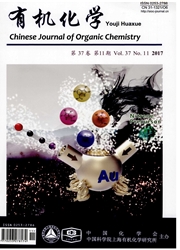

 中文摘要:
中文摘要:
合成了1,5-二(对甲氧基二苯胺)蒽(1)、2,6-二(对甲氧基二苯胺)蒽(2)和9,10-二(对甲氧基二苯胺)蒽(3)三种化合物,对它们的电化学、吸收和发射光谱、光谱电化学以及胺-胺电子耦合开展研究.三种化合物在+0.6-+1.0 V vs Ag/AgCl区域存在两步可逆氧化还原过程,两个氧化还原过程电位差△E在100 mV左右.单电子氧化产物1·+在近红外区域观测到弱价间电荷转移吸收(IVCT),电子耦合常数Vab估算为600 cm-1.化合物3·+观测到强IVCT吸收,其Vab估算为1440 cm-1.单电子氧化产物2·+则没有观测到明显IVCT吸收,表明有机胺在蒽桥基上的取代位置对胺-胺电子耦合程度有重要的影响.
 英文摘要:
英文摘要:
Three diamine compounds with an anthracene bridge were synthesized and characterized, including 1,5-bis(di-p-anisylamine)anthracene (1), 2,6-bis(di-p-anisylamine)anthracene (2) and 9,10-bis(di-p-anisylamine)anthracene (3). The elec-trochemistry, absorption and emission spectra, spectroelectrochemistry, and amine-amine electronic coupling of these compounds were examined. All compounds display two consecutive redox couples in the potential region between +0.6 and +1.0 V vs Ag/AgCl, with a potential splitting △E of around 100 mV. In the one-electron-oxidized state, weak intervalence charge transfer (IVCT) transitions were observed for 1^·+ in the near-infrared (NIR) region and the electronic coupling parameter Vab was calculated to be 600 cm^-1. In contrast, compound 3^·+ displays an intense IVCT band in the NIR region with a Vab value of 1440 cm^-1. However, no distinct IVCT band was discernable for 2^·+, indicative of an eligible electronic coupling. This work demonstrates that the positions of the amine substituents on the anthracene bridge play a critical role in determining the degree of amine-amine electronic coupling.
 同期刊论文项目
同期刊论文项目
 同项目期刊论文
同项目期刊论文
 期刊信息
期刊信息
